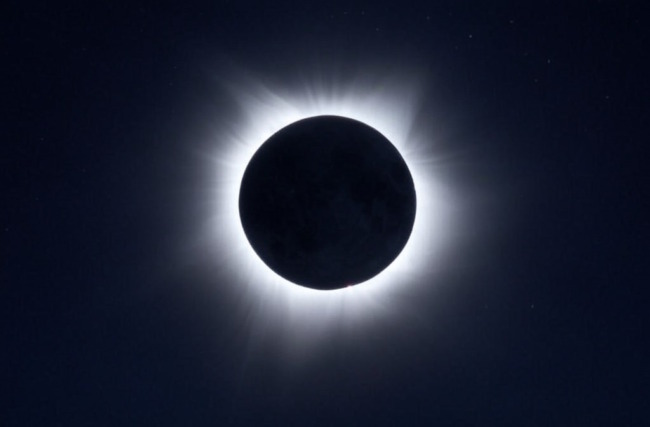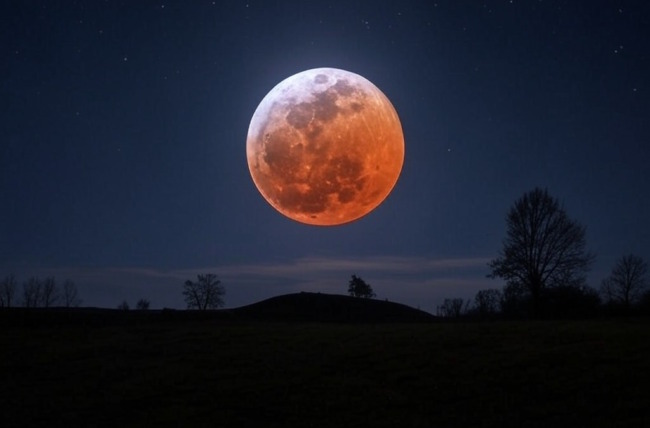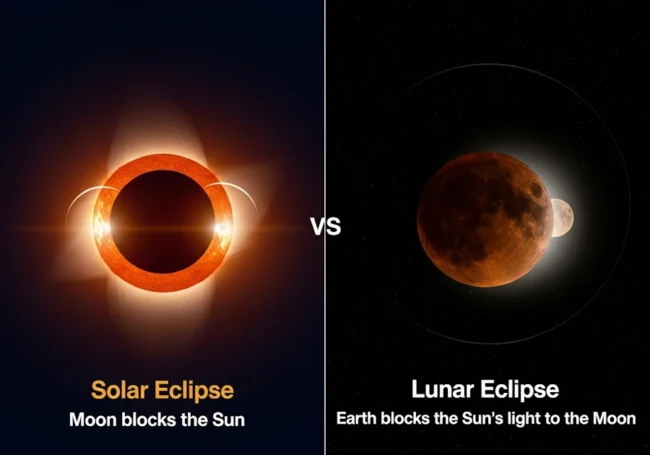Eclipses have profoundly influenced human understanding of the cosmos. Ancient civilizations used them to develop sophisticated calendars and predict celestial events. Solar eclipses, in particular, have advanced our scientific knowledge – the 1919 solar eclipse provided the first evidence supporting Einstein’s theory of general relativity by showing that starlight bent around the Sun exactly as his equations predicted.
Today, scientists still use eclipses to study the Sun’s corona, which is normally invisible due to the Sun’s intense brightness. Lunar eclipses help us understand Earth’s atmosphere, as the red light that reaches the Moon must pass through our atmosphere first.
The basic concept of eclipses
To understand eclipses, let’s first imagine a simple scenario: you’re holding a small ball in front of a light bulb. Your ball casts a shadow on the wall behind it. This is essentially what happens during both solar and lunar eclipses, just on a cosmic scale. The Sun is our light bulb, and either the Moon or Earth plays the role of the ball, depending on which type of eclipse we’re discussing.
Solar eclipses: when the Moon blocks our Sun
Imagine you’re enjoying a sunny day when gradually, the Moon passes directly between Earth and the Sun. This is a solar eclipse, one of nature’s most awe-inspiring phenomena. During this celestial dance, the Moon effectively becomes a giant umbrella in space, temporarily blocking sunlight from reaching certain parts of Earth.

The mechanics of a solar eclipse are fascinating. The Moon, despite being 400 times smaller than the Sun, appears almost exactly the same size as the Sun from Earth’s perspective. This is because the Moon is also approximately 400 times closer to Earth than the Sun. This remarkable coincidence enables the Moon to cover the Sun’s disk so precisely during a total solar eclipse.
The three types of Solar eclipses
The way we experience a solar eclipse depends on where the Moon is in its elliptical orbit around Earth:
- When the Moon is at the perfect distance and alignment, we witness a total solar eclipse. During totality, the sky darkens to an extent that stars become visible in daytime, temperatures drop noticeably, and animals often behave as if night has fallen. The Sun’s corona – its outer atmosphere – becomes visible as a ghostly white halo around the Moon’s dark silhouette.
- Sometimes, when the Moon is farther from Earth in its orbit, it appears slightly smaller than the Sun. This creates an annular eclipse, where a bright ring of sunlight surrounds the Moon’s dark circle – often called the “ring of fire.” Think of it like holding a small coin up to a larger light source; you’ll see light peeking around the edges.
- The most common type is a partial solar eclipse, where the Moon covers only a portion of the Sun. Imagine taking a bite out of a bright cookie – that’s what the Sun looks like during a partial eclipse.
Lunar eclipses: Earth’s shadow on the Moon
A lunar eclipse tells a different story. Here, Earth becomes the main player, positioning itself between the Sun and Moon. Earth casts its shadow onto the Moon’s surface, creating what ancient cultures often called a “blood moon” due to its reddish appearance.

Why red? This is where Earth’s atmosphere plays a crucial role. As sunlight passes through our atmosphere, it gets scattered. Blue light scatters more easily (which is why our sky appears blue), while red light tends to pass through. During a lunar eclipse, this red light gets bent around Earth’s edges and falls on the Moon’s surface, creating that characteristic coppery glow.
What are the Lunar eclipse types?
Lunar eclipses come in three varieties, each offering its own spectacular show:
1. Total eclipse
During a total lunar eclipse, Earth’s shadow completely engulfs the Moon. This process happens gradually over several hours, unlike the brief minutes of a total solar eclipse. We first see the Moon darken slightly as it enters Earth’s outer shadow (the penumbra), then watch as the darker inner shadow (the umbra) slowly creeps across the lunar surface until it’s completely covered.
2. Partial eclipse
A partial lunar eclipse occurs when only a portion of the Moon enters Earth’s main shadow. It’s like watching a cosmic cookie being partially dipped in chocolate – part of the Moon remains bright while the rest darkens dramatically.
3. Penumbral eclipse
The subtlest type is a penumbral eclipse, where the Moon passes through Earth’s faint outer shadow. These are often difficult to notice without careful observation, creating only a slight dimming of the Moon’s surface.
What are differences between Solar and Lunar eclipses?
1. The most practical difference lies in their visibility. A solar eclipse can only be seen from a narrow path on Earth where the Moon’s shadow falls – often just 100-160 kilometers wide. It’s like trying to catch a spotlight’s beam as it moves across a stage. In contrast, anyone on the night side of Earth can witness a lunar eclipse, since we’re all looking at the same Moon.
2. Duration also sets these events apart. A total solar eclipse’s peak moment (totality) lasts just a few minutes, while a total lunar eclipse can go on for hours. This difference occurs because Earth’s shadow is much larger than the Moon’s, taking longer for the Moon to pass through it.
3. Safety considerations differ significantly too. Solar eclipses require special eye protection because looking directly at the Sun, even when partially covered, can cause permanent eye damage. Lunar eclipses, however, are completely safe to view with the naked eye – they’re no brighter than the normal full Moon.
| Feature | Solar Eclipse 🌞 | Lunar Eclipse 🌕 |
|---|---|---|
| Occurs When | The Moon passes between the Sun and Earth, blocking sunlight. | The Moon moves into Earth’s shadow as our planet aligns between it and the Sun. |
| Visibility | Only visible in a narrow path on Earth. | Can be seen from any location where it is nighttime on Earth. |
| Frequency | Happens 2-5 times a year but is only visible in specific locations. | Happens 2-3 times a year and is visible to a larger area. |
| Types | Total, Partial, Annular | Total, Partial, Penumbral |
| Moon Phase | Happens only during a New Moon. | Happens only during a Full Moon. |
| Duration | A few minutes (totality lasts up to ~7.5 min). | Can last for several hours. |
| Safety | Dangerous to look at without proper eye protection. | Safe to watch with the naked eye. |
| Color of the Moon | Not visible (blocked by the Sun). | Can turn red due to Earth’s atmosphere filtering sunlight (Blood Moon). |
What makes a solar eclipse more rare?
Solar eclipses are not actually rarer than lunar eclipses in terms of frequency of occurrence. However, they are considered more rare from an observer’s perspective on Earth due to several factors:
- Visibility area: A lunar eclipse is visible from anywhere on the night side of Earth, which is about half the planet’s surface. In contrast, a solar eclipse is only visible from a narrow path on Earth’s surface, typically less than 1% of the globe.
- Shadow size: The Moon’s shadow cast on Earth during a solar eclipse is much smaller (about 480km or 300 miles wide) compared to Earth’s shadow on the Moon during a lunar eclipse.
- Duration: Solar eclipses last only a few minutes in any given location, while lunar eclipses can last for several hours.
- Frequency at a specific location: While solar and lunar eclipses occur in roughly equal numbers globally (about two of each per year), a specific location on Earth witnesses a total solar eclipse approximately once every 360 to 410 years on average.
- Viewing conditions: Solar eclipses require clear skies and special eye protection for safe viewing, making them more challenging to observe compared to lunar eclipses, which can be safely viewed with the naked eye.
These factors combined make solar eclipses, especially total solar eclipses, much more difficult to witness than lunar eclipses, contributing to their perceived rarity.
Sources we used to write this article:
- https://www.sciencefocus.com/space/why-are-solar-eclipses-rarer-than-lunar-eclipses
- https://www.reddit.com/r/askscience/comments/aiha4d/is_earth_extremely_rare_to_have_a_perfect_solar/
- https://indianexpress.com/article/explained/explained-sci-tech/total-solar-eclipse-rare-9255264/
- https://www.usatoday.com/story/news/nation/2024/04/08/solar-vs-lunar-eclipses-types-explained/73241427007/
- https://manoa.hawaii.edu/exploringourfluidearth/physical/tides/tidal-movements/weird-science-eclipses
- https://perlan.is/articles/solar-eclipse-vs-lunar-eclipse
- https://www.weather.gov/fsd/suneclipse
- https://science.nasa.gov/moon/eclipses/

Leave a Reply